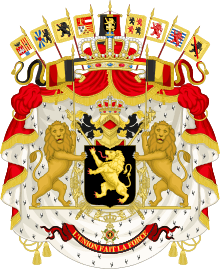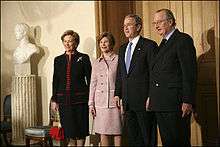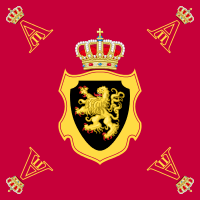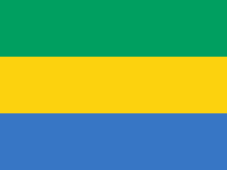Albert II of Belgium
| Albert II | |||||
|---|---|---|---|---|---|
 Albert II in 2010 | |||||
| King of the Belgians | |||||
| Reign | 9 August 1993 – 21 July 2013 | ||||
| Predecessor | Baudouin | ||||
| Successor | Philippe | ||||
| Prime Ministers | |||||
| Born |
6 June 1934 Stuyvenberg Castle, Laeken, Brussels, Belgium | ||||
| Spouse | |||||
| Issue Detail | |||||
| |||||
| House | Belgium | ||||
| Father | Leopold III of Belgium | ||||
| Mother | Princess Astrid of Sweden | ||||
| Signature |
| ||||
 |
Albert II[2] (born 6 June 1934) reigned as the King of the Belgians from 1993 until his abdication in 2013.
King Albert II is the son of King Leopold III and Queen Astrid, born princess of Sweden. He is the younger brother of Grand Duchess Joséphine-Charlotte of Luxembourg and King Baudouin, whom he succeeded upon Baudouin's death in 1993. He is currently the last living child of Leopold III and Astrid. He married Donna Paola Ruffo di Calabria (now Queen Paola), with whom he had three children. Albert's elder son, Philippe, is the current King of the Belgians.
On 3 July 2013, King Albert II attended a midday session of the Belgian cabinet. He then announced that, on 21 July, Belgian National Day, he would abdicate the throne for health reasons. He was succeeded by his son Philippe on 21 July 2013. Albert II was the fourth monarch to abdicate in 2013, following Pope Benedict XVI, Queen Beatrix of the Netherlands, and Emir Hamad bin Khalifa of Qatar.[3] In so doing, he was also the second Belgian monarch to abdicate, following his father Leopold III who abdicated in 1951, albeit under very different circumstances.
Early life
Prince Albert was born in Stuyvenberg Castle, Brussels, as the second son and youngest child of King Leopold III and his first wife, Princess Astrid of Sweden. He was second in line to the throne at birth, and was given the title Prince of Liège. Queen Astrid died in a car accident on 29 August 1935, in which King Leopold was lightly injured but survived. The King remarried to Mary Lilian Baels in 1941, a union that produced three more children: Prince Alexandre, Princess Marie-Christine and Princess Marie-Esméralda.
During World War II, on 10 May 1940, at the time when Belgium was being invaded, Prince Albert, his elder sister Princess Joséphine-Charlotte and his elder brother Prince Baudouin, left the country for France and later Spain. The Prince and the Princess returned to Belgium on 2 August 1940. They continued their studies until 1944, either at Laeken, or at the Castle of Ciergnon in the Ardennes. In June 1944, at the time of the Allied landings, King Leopold, his wife Princess Lilian and the royal children were deported by the Germans to Hirschstein, Germany, and later to Strobl, Austria, where they were liberated by the American Army on 7 May 1945. Owing to the political situation in Belgium, King Leopold and his family moved to the villa "Le Reposoir" in Pregny, Switzerland, when they left Austria in October 1945 and stayed until July 1950. During that time, Prince Albert would continue his education in a secondary school in Geneva. King Leopold III, accompanied by Prince Baudouin and Prince Albert, returned to Belgium on 22 July 1950.[1]
Marriage and family

In 1958, Albert went to the Vatican to witness the coronation of Pope John XXIII. At a reception at the Belgian Embassy, he met Italian Donna Paola Ruffo di Calabria. Prince Albert proposed marriage to her, to which she accepted. Two months after their meeting, the prince introduced his future wife to his family, and four months later to the press. The couple married on 2 July 1959 and have three children, two sons and a daughter, twelve grandchildren and one great-grandchild:
- King Philippe of the Belgians (born 15 April 1960 at Belvédère Castle). On 4 December 1999, the then Duke of Brabant married Jonkvrouwe Mathilde d'Udekem d'Acoz (born 20 January 1973), who was created Princess Mathilde of Belgium a day before their marriage. She is a daughter of the late Count Patrick d'Udekem d'Acoz and his wife, Countess Anna Maria Komorowska. The current King and Queen have four children, two sons and two daughters:
- The Duchess of Brabant (Élisabeth Thérèse Marie Hélène) (born 25 October 2001 at Erasmus Hospital in Bussels), heiress apparent
- Prince Gabriel of Belgium (born 20 August 2003 at Erasmus Hospital in Bussels)
- Prince Emmanuel of Belgium (born 4 October 2005 at Erasmus Hospital in Bussels)
- Princess Eléonore of Belgium (born 16 April 2008 at Erasmus Hospital in Bussels)
- Princess Astrid of Belgium (born 5 June 1962 at Belvédère Castle). On 22 September 1984, she married Archduke Lorenz of Austria-Este, Archduke of Austria, Prince Royal of Hungary and Bohemia (born 16 December 1955), who was created a Prince of Belgium in 1995. They have five children, two sons and three daughters:
- Prince Amedeo of Belgium, Archduke of Austria-Este (born 21 February 1986 at Saint Luc University Hospital) married on 5 July 2014 to Elisabetta Rosboch von Wolkenstein. On May 17, 2016 Albert became a great-grandfather to Archduchess Anna Astrid, the daughter of his eldest grandchild Prince Amedeo of Belgium, Archduke of Austria-Este.
- Princess Maria Laura of Belgium, Archduchess of Austria-Este (born 26 August 1988 at Saint Luc University Hospital)
- Prince Joachim of Belgium, Archduke of Austria-Este (born 9 December 1991 at Saint Luc University Hospital)
- Princess Luisa Maria of Belgium, Archduchess of Austria-Este (born 11 October 1995 at Saint Jean Hospital in Brussels)
- Princess Laetitia Maria of Belgium, Archduchess of Austria-Este (born 23 April 2003 at Saint Jean Hospital in Brussels)
- Prince Laurent of Belgium (born 19 October 1963 at Belvédère Castle ). On 12 April 2003, he married Claire Coombs (born 18 January 1974), an Anglo-Belgian former real-estate agent. She was created Princess Claire of Belgium 11 days before their marriage. They have three children, twin sons and one daughter:
- Princess Louise of Belgium (born 6 February 2004 at Saint Luc University Hospital)
- Prince Nicolas of Belgium (born 13 December 2005 at Saint Luc University Hospital, twin)
- Prince Aymeric of Belgium (born 13 December 2005 at Saint Luc University Hospital, twin)
Since 1999, the media have claimed that the Belgian sculptor Delphine Boël (born in 1968) is King Albert II's extramarital daughter. In June 2013, Boël summoned the then King, the then Duke of Brabant and the Archduchess of Austria-Este to appear in court. She hoped to use DNA tests to prove that she is the King's daughter. As the King enjoyed complete immunity under the law, Boël decided to summon his elder children as well.[4][5] After the King's abdication, she abandoned her first suit to introduce a second one only against the King as he was no longer protected by immunity and the first claim would have been judged according to the situation at the time of the introduction of the claim.[6] In March 2017, the Court ruled that her claim was unfounded, and her lawyers said she would take the claim to appeal.[7]
Official role

As the younger brother of King Baudouin, Prince Albert was the heir-presumptive to the throne. However, his son Prince Philippe was groomed to be Baudoin's successor, once it became clear that the King would have no children to succeed him. Despite this, on Baudouin's death (at age 62), Albert was sworn in before parliament, on 9 August 1993, as the sixth King of the Belgians.[8]
As King, Albert's duties included representing Belgium at home and abroad on state visits, trade missions, and at high level international meetings as well as taking an interest in Belgian society, culture and enterprise.[9]
In 1984, he set up the Prince Albert Foundation, to promote expertise in foreign trade.[10]
The King had a constitutional role which came into play in 2010–2011 when Belgium's parliament was unable to agree on a government. When the crisis was resolved, Albert swore in the new government.[11]
Albert sparked controversy in his December 2012 Christmas speech by comparing modern "populist movements" with those of the 1930s. This was seen by several political commentators, as well as many Flemish politicians, as aimed implicitly at the large Flemish nationalist party, the N-VA.[12] Bart De Wever, the party's leader, called for the King's role in the formation of Belgian governments to be changed in the wake of this comment since he "could no longer see the monarch as playing the constitutional role of referee."[12]
Abdication
On 3 July 2013, 79-year-old King Albert II attended a midday session of the Belgian cabinet, where he revealed his intention to abdicate to Prime Minister Elio Di Rupo and to the Deputy Prime Ministers. According to a letter sent by the King to the Prime Minister and dated 3 July 2013, and which was made public, the King had already broached the topic of his intention to abdicate several times with the Prime Minister, who had asked him to reconsider it.[13] At 6 PM (CET) the King announced in a recorded radio and television speech that on 21 July, Belgium's National Day, he would abdicate the throne for health reasons. He was succeeded by his son, Philippe.[3] Albert II retained the title of King after the abdication,[14] and has since been styled as His Majesty King Albert II of Belgium.
Titles, styles, honours and arms
.svg.png)
Titles
- 6 June 1934 – 7 June 1934: His Royal Highness Prince Albert of Belgium
- 7 June 1934 – 9 August 1993: His Royal Highness The Prince of Liège
- 9 August 1993 – 21 July 2013: His Majesty The King of the Belgians
- 21 July 2013 – present: His Majesty King Albert II of Belgium
After his abdication on 21 July 2013 it was decided that he would be styled as His Majesty King Albert II,[15] the same form of address granted to his father, Leopold III, after his abdication.
Honours

Belgian honours
- Order of Leopold
- (-1993): Grand Cordon
- (1993-2013): Grand Master
- (2013-current): Grand Cordon
- Former Grand Master (1993-2013) of the Order of Leopold II
- Former Grand Master (1993-2013) of the Order of the African Star (dormant order)
- Former Grand Master (1993-2013) of the Royal Order of the Lion (dormant order)
- Former Grand Master (1993-2013) of the Order of the Crown
Foreign honours






































.svg.png)







Dynastic honours
.svg.png)
.svg.png)
Honorary degrees
King Albert II is Doctor Honoris Causa of:
Eponiem
- King Albert II boulevard, Brussels.
- Institute King Albert II, University hospital of Saint-Luc.[64]
Ancestry
See also
- Line of succession to the Belgian throne
- Crown Council of Belgium
- Royal Trust
- Prince Albert Fund
- Michel Didisheim, former private secretary
- Jacques van Ypersele de Strihou , former chief of the Kings Cabinet.
- Frank De Coninck, (former) Marshal of the Royal Household
References
- 1 2 "King Albert II". The Belgian Monarchy. Archived from the original on 25 April 2010. Retrieved 28 April 2010.
- ↑ Albert's full name is Albert Félix Humbert Théodore Christian Eugène Marie in French (pronounced [albɛʁ feliks œ̃bɛʁ teodɔʁ kʁistjɑ̃ øʒɛn maʁi]), Albert Felix Humbert Theodoor Christiaan Eugène Marie in Dutch (pronounced [ˈɑlbərt ˈfeːlɪks ˈɦɵmbərt teːjoːˈdoːr ˈkrɪstijaːn øːˈʒɛːn maːˈriː]), and Albrechtt Felix Humbert Theodor Christian Eugen Maria in German (pronounced [ˈʔalbʁɛkt ˈfeːlɪks ˈhʊmbɛʁt ˈteːodoːɐ̯ ˈkʁɪsti̯an ˈʔɔʏɡn̩ maˈʁiːaː]).[1]
- 1 2 Matthew Price. "Belgium's King Albert II announces abdication". Bbc.co.uk.
- ↑ Stroobants, Jean-Pierre (17 June 2013). "En Belgique, la fille adultérine d'Albert II exige une reconnaissance officielle". Le Monde. Retrieved 23 June 2013.
- ↑ Bacchi, Umberto (18 June 2013). "Belgium: King Albert's 'Disowned Natural Daughter' Delphine Boel Seeks Recognition in Court". International Business Times. Retrieved 23 June 2013.
- ↑ Le Vif, "Chacun sait que le roi Albert est le père biologique de Delphine Boël"
- ↑ Het Niewsblad 28 March 2017 http://www.nieuwsblad.be/cnt/dmf20170328_02804662 Retrieved 3 August 2017 (in Dutch)
- ↑ "The Belgian Monarchy: Home – Royal Family – King Albert II". The Belgian Monarchy.
- ↑ "The Belgian Monarchy: Home – The Monarchy today". The Belgian Monarchy.
- ↑ "The Belgian Monarchy: Home – The Monarchy today – Royal Initiatives – Prince Albert Fund". The Belgian Monarchy.
- ↑ "Belgium swears in new government headed by Elio Di Rupo". BBC News. 6 December 2011.
- 1 2 "Belgium King Albert II Christmas speech sparks controversy". BBC News Online. 27 December 2012. Retrieved 2 January 2013.
- ↑ "Letter of King Albert II to Prime Minister Di Rupo announcing his intention to abdicate". Scribd.com.
- ↑ Freek Willems, Dirk Reynaers. "België heeft vanaf 21 juli 2 koningen en 3 koninginnen (Dutch)". Deredactie.be.
- ↑ ""Koning der Belgen" versus "Koning" (Dutch)". Deredactie.be.
- 1 2 3 4 5 6 7 8 9 10 11 12 13 Carnet Mondain, [Carnet Mondain, p. 2 ed. 2005] book page with Alberts honours
- ↑ "Reply to a parliamentary question" (PDF) (in German). p. 53. Retrieved 4 October 2012.
- ↑ "The Belgian Monarchy".
- ↑ "Congolese President Joseph Mobutu flanked by Belgian King Baudouin". Retrieved 2017-01-17.
- ↑ "November 11, 1969 - Gen. Mobutu on official visit to Brussels - Image". Retrieved 2017-01-17.
- ↑ Order of the Elephant - Image
- ↑ Order of the Elephant - additional image
- ↑ "Archived copy". Archived from the original on 2 February 2017. Retrieved 26 January 2017.
- ↑ "Finnish President Visit To Belgium - Day One Photos and Images - Getty Images".
- ↑ "President of Greece State Visit To Belgium Photos and Images - Getty Images".
- ↑ Souverains.jpg
- ↑ "The Holy Sepulchre Ordre".
- ↑ John XXIII image
- ↑ "Hungary?s President Laszlo Solyom on State Visit to Belgium Day 1 Photos and Images - Getty Images".
- ↑ "Hungary?s President Laszlo Solyom on State Visit to Belgium Day 1 Photos and Images - Getty Images".
- ↑ "Fálkaorðuhafar". Falkadb.forseti.is. 21 October 1936. Archived from the original on 13 March 2016. Retrieved 19 November 2016.
- ↑ "Archived copy". Archived from the original on 28 September 2013. Retrieved 2013-07-09.
- ↑ "Archived copy". Archived from the original on 28 September 2013. Retrieved 2012-05-12.
- ↑ "The Belgian King Albert II (L) and Queen Paola (2ndL) and their eldest son, crown Prince Philippe of Belgium (C) are welcomed by Japanese Empress Michiko and Emperor Akihito, at the Imperial Palace..."
- ↑ "2011maijs-tzoregistrs.doc". president.lv. Archived from the original (doc) on 4 March 2016. Retrieved 30 December 2016.
- ↑ "President of the Republic of Lithuania - The Belgian Royal Couple pays the first visit to Lithuania".
- ↑ "Henri, Grand Duke of Luxembourg and Maria Teresa, Grand Duchess of Luxembou Photos and Images - Getty Images".
- ↑ "Henri, Grand Duke of Luxembourg and Maria Teresa, Grand Duchess of Luxembou Photos and Images - Getty Images".
- ↑ "Semakan Penerima Darjah Kebesaran, Bintang dan Pingat".
- 1 2 Carnet Mondain, p. 2 ed. 2005
- ↑ "Monaco Royal Wedding - The Religious Wedding Ceremony".
- ↑ "Image - red carpet". Archived from the original on 16 June 2013. Retrieved 30 December 2016.
- ↑ "Queen Paola and King Albert image". PurePeople. Archived from the original on 30 December 2016. Retrieved 30 December 2016.
- ↑ "Dutch Royal Family Make State Visit To Belgium - Day 1".
- ↑ "2006.06.20____.jpg (image)".
- ↑ "Anefo_911-3015_Tweede_dag.jpg". wikimedia. Archived from the original on 30 December 2016. Retrieved 30 December 2016.
- ↑ Huwelijk_prinses_Beatrix_en_prins_Claus.jpg
- ↑ "picture:1279009". belga.be. Archived from the original on 13 July 2012. Retrieved 30 December 2016.
- ↑ "The Belgian Monarchy".
- ↑ "The Belgian Monarchy".
- ↑ "Portuguese State Visit To Belgium Photos and Images - Getty Images".
- ↑ "Portuguese State Visit To Belgium Photos and Images - Getty Images".
- ↑ http://canord.presidency.ro/Ord.St.Rom..xls
- ↑ "Wedding image". Archived from the original on 30 December 2016. Retrieved 30 December 2016.
- ↑ Boletín Oficial del Estado
- ↑ "sp07359f.jpg". Blogspot. Archived from the original on 30 December 2016. Retrieved 30 December 2016.
- ↑ "BOE.es - Documento BOE-A-1978-7199".
- ↑ "picture:471649". belga.be. Archived from the original on 5 December 2012. Retrieved 30 December 2016.
- ↑ "Fairy Tales".
- ↑ "Editorial & News Images: News Photography, Pictures, Awards, Events, Sports, Celebrity Photos - Getty Images".
- ↑ The Royal Forums
- ↑ "Royal Victorian Order image". GettyImages. Archived from the original on 16 June 2013. Retrieved 30 December 2016.
- ↑ Royal Victorian order additional image
- ↑ "Institut Roi Albert II - Cliniques universitaires Saint-Luc".
External links
| Wikimedia Commons has media related to Albert II of Belgium. |
- Official Belgian monarchy web site
- "Belgium defends king against 'assault'". BBC News. 18 September 2001.
- The Royal Belgium Orders
Albert II of Belgium Born: 6 June 1934 | ||
| Regnal titles | ||
|---|---|---|
| Preceded by Baudouin |
King of the Belgians 1993–2013 |
Succeeded by Philippe |
| Academic offices | ||
| Preceded by Robert van Schendel |
Speaker at the College of Europe Opening Ceremony 1969 |
Succeeded by Jean Rey |